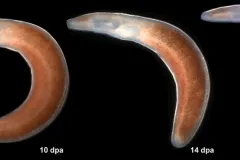Ribbon Worm Redux

Even on an early winter morning, it was sunny and warm in southern Florida. This was great because, regardless of the weather, Dr. Jon Norenburg and I were going to walk chest-deep into the water to scrape off animals encrusting some pier pilings near Miami Beach. Composed mostly of barnacles, sponges and sea squirts, this crust also harbors our quarry: intertidal ribbon worms, or nemerteans. We were looking for them to study their ability to regenerate missing ends after amputation.
We have all probably heard about regeneration: if an earthworm is cut in two, each piece can sometimes grow back the missing end, resulting in two worms. This ability is also found in a wide variety of other animals. Even some vertebrates show amazing regenerative power: certain newts can grow back a complete limb! Isn’t it a pity that we humans cannot? Well, many researchers believe that by studying how some animals regenerate, we might be able to help people to heal and regenerate too.
In order to learn more, we've been studying the evolutionary history of the ribbon worm to better understand whether its ancestors had the ability to regenerate and if the ability can be gained or lost through evolutionary change. To answer this, I have been collecting species from various branches of the nemertean family tree and looking to see which ones can grow back both missing ends when cut in two.
Nemerteans were once thought to have many species capable of regeneration. However, scientists have since concluded that all of those species were actually the same one, Ramphogordius sanguineus. In our search for worms, we were lucky to find a different species that researchers believed could regenerate (Baseodiscus delineatus), along with some other species that we could test. I brought them back to the lab and found out that cut Baseodiscus regenerated their heads. Most other species failed to do so, although one species we collected by accident (Neolineus sp.) regenerated too!
After fitting our new findings into the nemertean family tree, it seems likely that the ribbon worm ancestor was not capable of growing back its head. However, this suggests that regeneration has evolved a few times since then in different species, which could actually make it easier to study the evolution of this ability. There are many species of nemerteans and we have examined only a few, so there are plenty of reasons to go back to the sea and keep looking.

